Ivan Aivazovsky, one of the most celebrated maritime painters of the 19th century, created luminous seascapes that capture the movement and vastness of the sea with extraordinary realism. His works are highly sought after, often requiring meticulous conservation and restoration to preserve their delicate balance of colour and light. One such significant painting was entrusted to Venizelos G. Gavrilakis and Vaia A. Karagianni, President and Head Director of VENIS STUDIOS, for comprehensive conservation and restoration treatments.

©VENIS STUDIOS
The painting exhibited multiple signs of deterioration, primarily due to natural ageing processes and environmental conditions that had compromised its structural and visual integrity. One of the most pressing issues was the presence of a thick, yellowed varnish layer, which had significantly altered the original chromatic harmony, diminishing the vibrancy and depth of Aivazovsky’s colour palette. Additionally, surface contaminants, including dust, soot, and airborne pollutants, had settled into the paint layers over time, further dulling the image and obscuring fine details.
The canvas had also suffered from structural instability. Variations in humidity and temperature had resulted in a loss of tension, causing minor deformations across the surface. This was accompanied by areas of paint loss, particularly in sections where the brushwork was delicate, indicating mechanical stress and previous handling damage. Furthermore, the paint layer displayed a network of craquelure, with some fissures deep enough to suggest underlying adhesion problems between the paint and the ground layers. Careful analysis was required to determine the best course of action to stabilize and restore the artwork without compromising its authenticity.
Conservation & Restoration
Given the complexity of the painting’s condition, a structured and methodical approach was adopted to ensure stability and aesthetic recovery while adhering to ethical conservation and restoration principles.
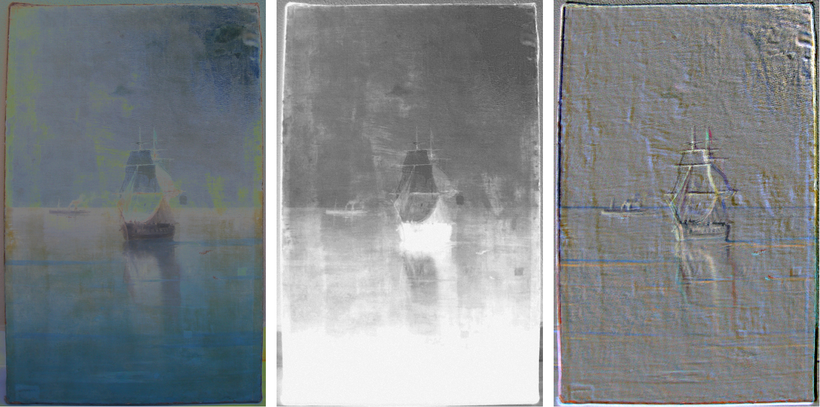
Research
©VENIS STUDIOS
The initial phase of the conservation and restoration process at VENIS STUDIOS begins with a comprehensive scientific observation of the Aivazovsky painting. This step involves the meticulous use of advanced imaging techniques, such as ultraviolet fluorescence, infrared reflectography, 3D RTI photography, etc, to analyze the artwork’s underlying structure, composition, damages and condition. High-resolution photographs are captured to document the state of the painting before any intervention. This scientific observation provides crucial data, guiding the subsequent stages of examination, documentation, conservation treatment, and restoration. VENIS STUDIOS follows a systematic methodology, prioritizing the preservation of the original materials while employing the highest quality materials and most carefully considered techniques. According the international museum high standards set by international preservation culture organizations and institutions such as UNESCO, IIC, AIC, etc. This approach ensures that every decision is informed by an in-depth understanding of the painting’s materials, techniques, and any deterioration or damage. This research-driven methodology exemplifies VENIS STUDIOS’ commitment to advancing the field of art conservation through scientific rigour and respect for the artist’s original vision.
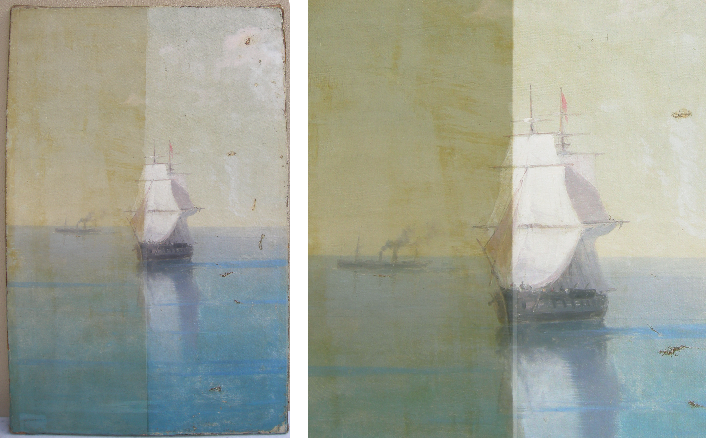
Surface Cleaning
©VENIS STUDIOS
The removal of surface contaminants was meticulously executed using delicate, controlled techniques under stereomicroscopic observation. This approach facilitated the precise elimination of accumulated grime while preserving the integrity of the fragile paint layer. Prior to full-scale cleaning, spot tests were conducted on small, inconspicuous areas to assess the efficacy of the cleaning agents and to ensure no adverse effects on the underlying paint. This preparatory phase was crucial in readying the painting for subsequent restoration treatments.
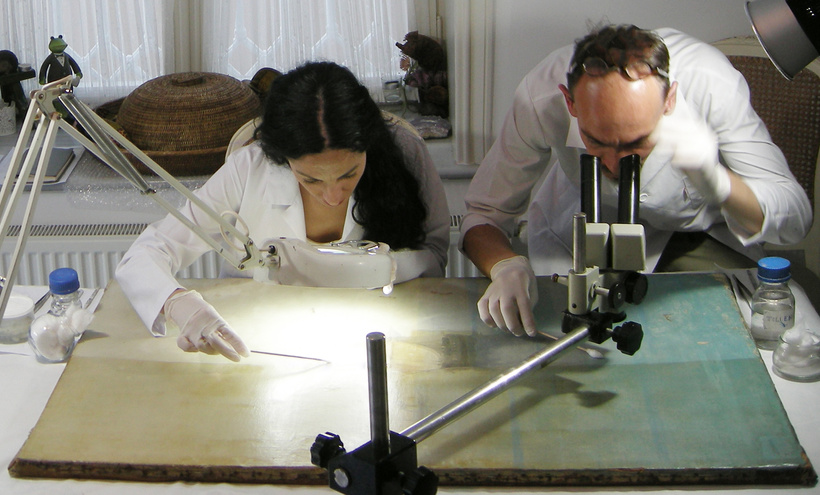
Varnish Removal
©VENIS STUDIOS
The discoloured and oxidized varnish layer, which had altered the tonal balance of the painting, was carefully removed in a chemical way. The approach was gradual and controlled, ensuring that only the unwanted varnish was dissolved while preserving the original paint. As the varnish was removed, the depth and luminosity of Aivazovsky’s seascape re-emerged, revealing intricate details that had long been obscured.
Structural Consolidation
Addressing the weakened canvas was a crucial step in ensuring the long-term stability of the painting. Using reversible conservation traditional adhesives, the fragile areas of the canvas were consolidated to reinforce its strength. Additionally, a careful re-tensioning process was undertaken to correct minor deformations, restoring the painting’s original form while maintaining its historical integrity.
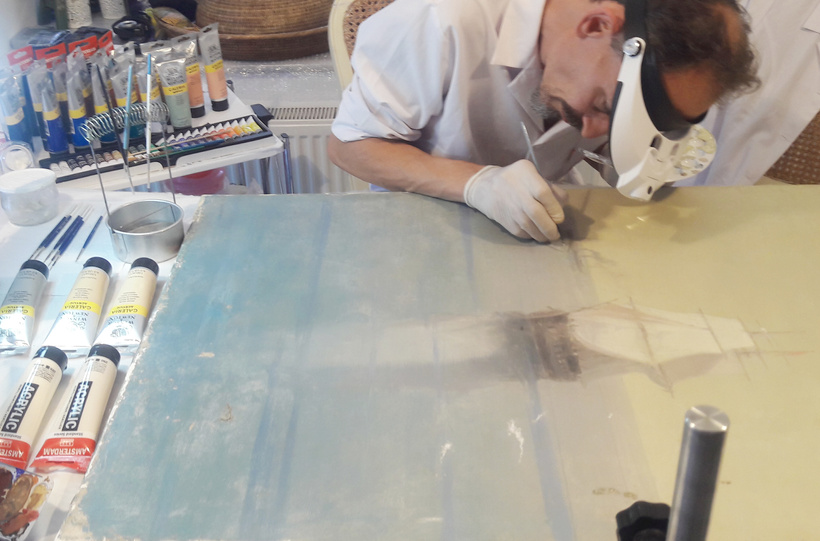
Retouching
©VENIS STUDIOS
Where the original paint layer had suffered loss, precise retouching was performed using reversible special pigments. The goal was to integrate these areas seamlessly with the surrounding colours while ensuring that any retouching remained visually distinguishable under ultraviolet (UV) light. This practice is essential in conservation ethics to maintain transparency about alterations made to the artwork.
Varnishing
To complete the conservation and restoration treatments, a special varnish for historical paintings was applied. This layer not only enhanced the painting’s optical depth but also provided a protective barrier against environmental pollutants. The chosen varnish was non-yellowing and fully reversible, ensuring that future conservation efforts would not be hindered.
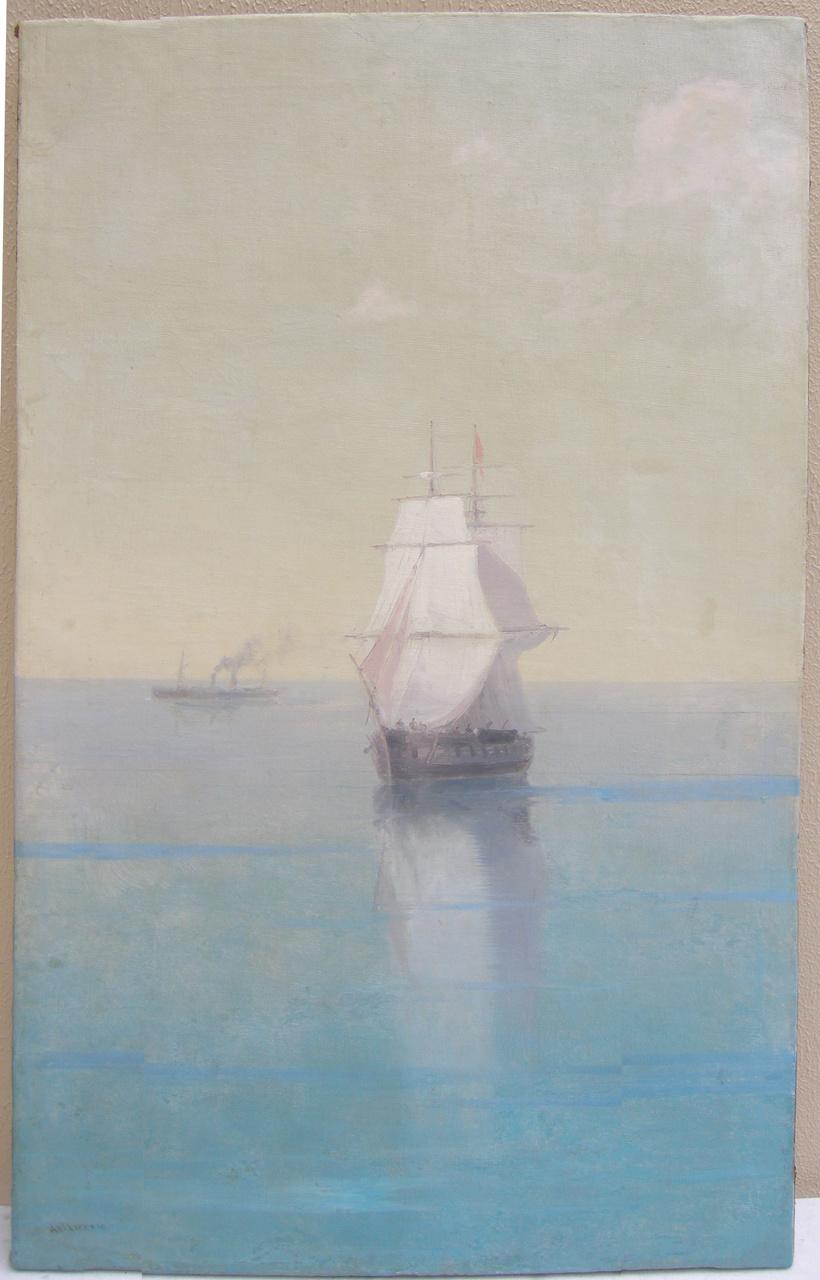
©VENIS STUDIOS
Following meticulous conservation and restoration treatments, the painting has been revitalized, recapturing its original luminosity and depth. The seamless transitions of color and the dramatic interplay of light and water—hallmarks of Aivazovsky’s mastery—are once again vividly apparent. This conservation and restoration exemplifies the vital role of professional conservation in safeguarding cultural heritage, allowing the profound artistic and historical significance of the work to endure.
The conservation and restoration were led by Venizelos G. Gavrilakis, Senior Expert Art and Antiquities Conservator and Restorer, and Vaia A. Karagianni, Expert Art and Antiquities Conservator and Restorer of VENIS STUDIOS. Their work underscores the intersection of science and art in conservation and restoration, demonstrating how methodical research, technical expertise, and ethical practices can ensure the longevity of historical masterpieces. By adhering to the highest standards of conservation and restoration ethics and employing advanced restoration techniques, this project reaffirms VENIS STUDIOS’ unwavering commitment to preserving artistic legacies and honouring the vision of one of history’s greatest maritime painters.
I want to learn more:
by Venizelos G. Gavrilakis
Edited Athina Gkouma
About the author:
Venizelos G. Gavrilakis, a renowned Senior expert art and antiquities conservator and restorer one of the few internationally experts of Byzantine and post-Byzantine icons, his expertismes expand also in historical oil paintings, and Ottoman-era artwork, historical artworks and antiquities. He has been working as a senior expert conservator and restorer since 1994 for more than 30 years. He has worked with various institutions and has been involved in international conservation meetings and conferences. He has also made 3 art restoration and conservation documentaries which they have been played on TV and cinemas. Gavrilakis is the president of the art and antiquities conservation and restoration company VENIS STUDIOS, based in Istanbul, Turkey, and has collaborated with goverment departments, museums, galleries, antique dealers, and private collectors.
-
Articles: World Art News articles
Our related articles

